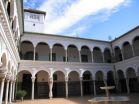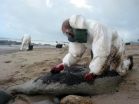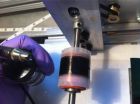(Press-News.org) Bochum biophysicists in collaboration with the MPI Dortmund have for the first time measured the orientation of the Ras protein bound to the cell membrane. The RUB team combined the use of three biophysical methods - infrared spectroscopy, computer simulations and fluorescence measurements - and came to the surprising conclusion that two Ras molecules form a pair to take an upright position on the membrane. It was previously assumed, based on computer simulations, that the protein is located horizontally on the membrane as single molecule. Ras is the central "switch" for cell growth, and malfunction of this protein is an important factor in the development of cancer. "These results put a completely new light on the nano-cluster formation of Ras at the membrane," said Professor Dr. Klaus Gerwert from the RUB Faculty of Biology and Biotechnology. The study was chosen as the cover story for the Biophysical Journal.
Orientation affects protein interactions
The orientation of a protein affects its possible interactions with other proteins. "This is similar to comparing the situations of a guest being welcomed with open arms and the host lying on the couch during the greeting," illustrates Dr. Jörn Güldenhaupt, who conducted the orientation measurements. Few biophysical methods allow the protein orientation to be determined. ATR-FTIR spectroscopy, which has been established by the Chair for Biophysics, is one of them.
Ras molecules are mutually supportive
The false assumption that Ras lies on the membrane was based on earlier computer simulations. Till Rudack from the Bochum research team also took a virtual look at Ras. The result: A single upright Ras molecule very quickly falls over and seems to lie on the membrane. "Something must have supported the Ras in our measurements," said Till Rudack. "And that could only be another Ras molecule that was not present in the simulation." In fact, further computer simulations of two mutually supportive Ras molecules yielded a stable upright orientation – which would fit the experimental results.
Fluorescence resonance energy transfer: a molecular yardstick
The team confirmed the results with another piece of experimental evidence using "FRET" (fluorescence resonance energy transfer). This is currently the best method for detecting interactions between two proteins. Here, researchers mark the Ras proteins with two different dyes. If the proteins interact, they are very close together so that energy is transferred from the one dye to the other. As with a yardstick, the distance between the proteins can be measured from the ratio of the transferred energy. For the Ras-Ras interaction, the biophysicists determined a distance of 4.6 nanometres, or millionths of a millimetre. This corresponded exactly to the distance they had predicted with their computer simulations for a "double-Ras".
Stronger in the group
Earlier studies had shown that Ras molecules are often concentrated in small groups. These so-called nano-clusters consist of four to ten Ras proteins. Up until now, it was assumed that other proteins have to mediate the formation of clusters. "We were able to demonstrate for the first time that Ras itself is actively involved," said Dr. Carsten Kötting, an Assistant Professor. The clustering is a great advantage for Ras. The proteins are able to pass on a signal more clearly in the group, i.e. with fewer errors. The SOS protein, for example, always transmits one signal simultaneously to two Ras molecules. If Ras is present in a double form (as a dimer), this step is much easier. An understanding of the stereo structure of Ras will allow us to adopt novel approaches in drug development. "So far, no drugs have been discovered which act directly on Ras," said Klaus Gerwert. "Ras is to be considered undruggable. The Ras-Ras interface could be a new starting point, however, in the development of Ras drugs."
###
Project grant
Financial support for the project has come from the Protein Research Department at RUB, from the State NRW as part of the Centre for Vibrational Microscopy (CVM) and from SFB 642 "GTP and ATP-dependent membrane processes" (Professor Gerwert is their spokesperson).
Bibliographic record
J. Güldenhaupt, T. Rudack, P. Bachler, D. Mann, G. Triola, H. Waldmann, C. Kötting, K. Gerwert (2012): N-Ras forms dimers at POPC membranes, Biophysical Journal, doi: 10.1016/j.bpj.2012.08.043
Further information
Prof. Dr. Klaus Gerwert, Chair for Biophysics, Faculty of Biology and Biotechnology at the Ruhr-Universität, 44780 Bochum, Germany, Tel. +49/234/32-24461
klaus.gerwert@bph.ruhr-uni-bochum.de
Cover Image of the Biophysical Journal
http://download.cell.com/images/journalimages/0006-3495/S0006349512X00201_covhighres.jpg
Editor: Dr. Julia Weiler
Cell growth protein Ras forms a 'pair' on the cell membrane
Upright instead of horizontal
2012-10-15
ELSE PRESS RELEASES FROM THIS DATE:
Traditional courtyards: an example of eco-efficiency for architects
2012-10-15
Researchers from the University of Seville (Spain) have used mathematical tools to assess what has been known for centuries: the temperature inside the typical Mediterranean courtyard is cooler than that of the street. Though seemingly common sense, understanding such information in detail helps to save energy and money, which is the objective of eco-efficient buildings.
The inhabitants of Mediterranean regions have known for centuries that during the summer their courtyards are cooler than the street. "Why then put air conditioning extractor units on rooftops or outer ...
Exposure to 'Prestige' fuel causes short-term damage to rat DNA
2012-10-15
An experiment carried out on rodents exposed to fuel similar to that of the Prestige tanker oil spill – which took place nearly a decade ago – shows that inhalation of the fuel causes damage to genetic material. According to the study, led by the University of A Coruña, the results could be used in relation to people who carry out the industrial cleaning of coasts.
On 19 November, it will be ten years since the sinking of the Prestige, which caused one of Spain's largest ecological disasters. The oil spill reached the coasts of Galicia and the rest of the Cantabrian coast, ...
Replicating risk genes in bipolar disorder
2012-10-15
Philadelphia, PA, October 15, 2012 – One of the biggest challenges in psychiatric genetics has been to replicate findings across large studies.
Scientists at King's College London, Institute of Psychiatry have now performed one of the largest ever genetic replication studies of bipolar affective disorder, with 28,000 subjects recruited from 36 different research centers. Their findings provide compelling evidence that the chromosome 3p21.1 locus contains a common genetic risk for bipolar disorder, the PBRM1 gene.
The locus at 3p21.1 has also been previously associated ...
Soccer scores a health hat trick for hypertensive men
2012-10-15
Playing soccer (football) could be the best way for people with high blood pressure, known as hypertension, to improve their fitness, normalise their blood pressure and reduce their risk of stroke. Research from Universities of Exeter and Copenhagen, and Gentofte University Hospital in Denmark, published today (Monday 15 October 2012) in the journal Medicine and Science in Sports and Exercise, suggests that soccer training prevents cardiovascular disease in middle-aged men with hypertension and is more effective than healthy lifestyle advice currently prescribed by GPs.
After ...
Programs for treating addiction in doctors pose ethical issues
2012-10-15
Philadelphia, Pa. (October 15, 2012) – State physician health programs (PHPs) play a key role in helping doctors with substance abuse problems. But the current PHP system is inconsistent and prone to potential conflicts of interest and ethical issues, according to a review available as publish ahead of print content from the December 2012 issue of Journal of Addiction Medicine, the official journal of the American Society of Addiction Medicine. The journal is published by Lippincott Williams & Wilkins, a part ofWolters Kluwer Health.
In the article, Drs J. Wesley Boyd ...
'Treasure trove' of film records unlocks history of British Cinema
2012-10-15
A film historian at Queen Mary, University of London has been uncovering the secret past of British cinema in a private collection of production records for thousands of films, including such iconic titles as Dr No, The African Queen, and Zulu.
The unique production archive is owned by Film Finances Ltd, underwriters of many major British films made since the 1950s. The company has kept complete documentation for
every production it has guaranteed, including letters, telegrams, shooting schedules, scripts, storyboards and even doctors' certificates.
In 2009, Film Finances ...
New techniques stretch carbon nanotubes, make stronger composites
2012-10-15
Researchers from North Carolina State University have developed new techniques for stretching carbon nanotubes (CNT) and using them to create carbon composites that can be used as stronger, lighter materials in everything from airplanes to bicycles.
By stretching the CNT material before incorporating it into a composite for use in finished products, the researchers straighten the CNTs in the material, which significantly improves its tensile strength – and enhances the stiffness of the composite material and its electrical and thermal conductivity.
State-of-the-art ...
Aggregation of proteins in cells may result in diseases
2012-10-15
Many diseases are caused by proteins losing their natural three-dimensional structure and thus their function. In most cases, the damaged proteins are degraded by different systems in the cells, but in some cases, the proteins begin to aggregate and form very well-organised rope-like structures called fibrils. These structures have now been linked to many different diseases, such as Alzheimer's, Parkinson's, type 2 diabetes and corneal dystrophies (opaqueness in the cornea).
It has long been known that corneal dystrophy is caused by a mutation of a protein called TGFBIp ...
The Romans used Greek myths in their mosaics as symbols of civilization
2012-10-15
This press release is available in Spanish.This line of research, coordinated by Luz Neira, who is a professor in the Department of Humanities: History, Geography and Art, as well as a researcher in UC3M's Institute for Culture and Technology (Instituto de Cultura y Tecnología), continues on the path established by previous studies that examined the images of women and certain legends in Roman mosaics. "We had previously shown the memory and conscious, self-interested reuse of myths, but this new volume also examines the possibility that there is a subliminal message regarding ...
Protein could be key for drugs that promote bone growth
2012-10-15
AUGUSTA, Ga. – Georgia Health Sciences University researchers have developed a mouse that errs on the side of making bone rather than fat, which could eventually lead to better drugs to treat inflammatory diseases such as rheumatoid arthritis.
Drugs commonly used to treat those types of conditions – called glucocorticoids – work by turning down the body's anti-inflammatory response, but simultaneously turn on other pathways that lead to bone loss. The result can lead to osteoporosis and an accumulation of marrow fat, says Dr. Xingming Shi, bone biologist at the GHSU ...
LAST 30 PRESS RELEASES:
Study showcases resilience and rapid growth of “living rocks”
Naval Research Lab diver earns Office of Naval Research 2025 Sailor of the Year
New Mayo-led study establishes practical definition for rapidly progressive dementia
Fossil fuel industry’s “climate false solutions” reinforce its power and aggravate environmental injustice
Researchers reveal bias in a widely used measure of algorithm performance
Alcohol causes cancer. A study from IOCB Prague confirms damage to DNA and shows how cells defend against it
Hidden viruses in wastewater treatment may shape public health risks, study finds
Unlock the power of nature: how biomass can transform climate mitigation
Biochar reshapes hidden soil microbes that capture carbon dioxide in farmland
Reducing saturated fat intake shows mortality benefit, but only in high-risk individuals
Manta rays create mobile ecosystems, study finds
Study: Mixed results in using lipoic acid to treat progressive multiple sclerosis
Norbert Holtkamp appointed director of Fermi National Accelerator Laboratory
New agentic AI platform accelerates advanced optics design
Biologists discover neurons use physical signals — not electricity — to stabilize communication
Researchers discover that a hormone can access the brain by hitchhiking
University of Oklahoma researcher awarded funding to pursue AI-powered material design
Exploring how the visual system recovers following injury
Support for parents with infants at pediatric check-ups leads to better reading and math skills in elementary school
Kids’ behavioral health is a growing share of family health costs
Day & night: Cancer disrupts the brain’s natural rhythm
COVID-19 vaccination significantly reduces risk to pregnant women and baby
The role of vaccination in maternal and perinatal outcomes associated with COVID-19 in pregnancy
Mayo Clinic smartwatch system helps parents shorten and defuse children's severe tantrums early
Behavioral health spending spikes to 40% of all children’s health expenditures, nearly doubling in a decade
Digital cognitive behavioral treatment for generalized anxiety disorder
Expenditures for pediatric behavioral health care over time and estimated family financial burden
Air conditioning in nursing homes and mortality during extreme heat
The Alps to lose a record number of glaciers in the next decade
What makes a good proton conductor?
[Press-News.org] Cell growth protein Ras forms a 'pair' on the cell membraneUpright instead of horizontal




